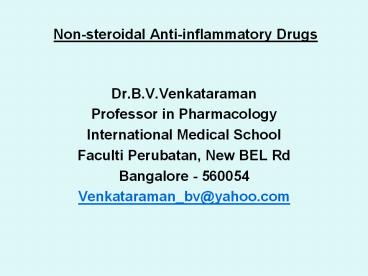Non-steroidal%20Anti-inflammatory%20Drugs - PowerPoint PPT Presentation
Title:
Non-steroidal%20Anti-inflammatory%20Drugs
Description:
Non-steroidal Anti-inflammatory Drugs Dr.B.V.Venkataraman Professor in Pharmacology International Medical School Faculti Perubatan, New BEL Rd Bangalore - 560054 – PowerPoint PPT presentation
Number of Views:179
Avg rating:3.0/5.0
Title: Non-steroidal%20Anti-inflammatory%20Drugs
1
Non-steroidal Anti-inflammatory Drugs
- Dr.B.V.Venkataraman
- Professor in Pharmacology
- International Medical School
- Faculti Perubatan, New BEL Rd
- Bangalore - 560054
- Venkataraman_bv_at_yahoo.com
2
COX
3
Physiological stimulus Inflammatory
stimulus
Macrophages/other cells
COX-1 Constitutive
Cox-2 Induced
Other inflammatory mediators
Proteases
PGs
TXA2 Platelets
PGI2, endothelium Stomach mucosa etc
PGE2, Kidney etc
INFLAMMATION
4
(No Transcript)
5
Classification of NSAID
- COX-1 and COX-2 inhibitors
- Salicylates Aspirin
- Para-aminophenols Phenacetin, Paracetamol.
- Pyrazolons Phenylbutazone
- Indoles Indomethacin, Sulindac, Tolmetin,
Ketorolac. - Phenylacetates Diclofenac
- Propionates Ibuprofen, Ketoprofen,
- Fenamates Flufenamic acid and Mefenamic acid.
- Oxicams Piroxicam
6
Classification of NSADs (contd)
- COX-2 inhibitors (Coxibs)
- Valdecoxib, etorocoxib
- COX-3 inhibitors
- Paracetamol
- Miscellaneous COX Inhibitors
- Nimesulide, Meloxicam, Etodolac etc
- Drugs do not inhibit PGs
- Nefopam
7
SALYCILATES
- Source bark of willow (used in malaria)
- Now it is commercially synthesised.
- Salicylic acid
- Sodium salicylate
- Acetyl salicylic acid (aspirin)
- Methyl salicylic acid (oil of winter green)
- Diflunisal is a derivative of aspirin.
8
SALICYLATES
- LOCAL ACTIONS
- Irritants
- Salicylic acid Keratolytic, used in ring worm
infection - Methyl salicylate counter irritant in relieving
joints and muscular pain
9
Aspirin systemic effects
- Analgesic
Aspirin
10
Types of Analgesis
- Two types
- Narcotic analgesics
- Relieve pain and produce sedative/hypnotic
effect e.g. morlphine, pethidine - 2. Non-narcotic analgesics
- Relieve pain with out affecting the
consciousness e.g. aspirin, paracetamol
11
Systemic actions of aspirin
- Antipyretic action Inhibition of central PG
- Antiplatelet action
12
(Anti inflammatory action)
13
Systemic actions of aspirin
- TxA2 is present in platelets
- At any dose anti-platelet aggregation (inhibiting
TXA2) - At low dose PGI2 not inhibited
- At high dose PGI2 is inhibited.
- PGI2 vasodilator and anti-platelet aggregation.
- Action is irreversible.
- Duration 8-10 days (life of platelet)
14
Systemic actions of Salicylates
- Renal effect PGE2 (vasodilator) coordinate with
angiotensin-II. Chronic NSAIDs leads to
inhibition of PGE2 and vasoconstriction. - Respiration directly and indirectly. O2 leads to
CO2 which stimulates respiratory centre. These
events leads to hyper ventilation. - Low dose decrease the uric acid level. High dose
uricosuric effect.
15
Pharmacokinetics
- Well absorbed from stomach and small intestine
- Empty stomach and acid medium helps absorption
- Deacetylation in gut wall, liver, plasma other
tissues after absorption. - Protein binding 80
- Conjugated with glycine.
- 1/10 is excreted in active form which can be
enhanced with alkalinisation.
16
Side effects of aspirin
- Intolerance (rare) rashes, urticaria, asthma
etc. - Gastric irritation
- Hypoprothrombinemia Vit K is antidote
- Reyes syndrome Children prescribed for viral
fever. Syndrome consists of liver dysfunction
(fatal) - Salicylism headache, dizziness, vertigo,
difficulty in hearing and dimness of vision. The
symptoms are reversible once the drug is
withdrawn.
17
Treatment of acute salicylate poisoning
- Symptomatic treatment
- Patent airway
- Hyperthermia reduced by external cooling.
- Dehydration should be corrected.
- Vitamin K should be administered.
- Metabolic acidosis is corrected by NaHCO3 which
also promotes renal excretion of salicylates. - Forced diuresis is done by administration of
furosemide (40 mg) in the infusion fluid. - Dialysis is done in renal failure.
18
Clinical uses of Salicylates
- Keratolytic and antifungal salicylic acid
- Counter irritant Methyl salicylic acid
- Acute rheumatic fever Streptococcal infection
induces antibodies reacting with lymphocytes.
These antibodies react with heart valves and
myocardium. - Treatment
- a. Penicillin for the streptococcal infection.
- b. Aspirin (5-8 g in divided doses) for the
inflammation. - c.corticosteroids can also be given.
19
Clinical uses of aspirin
- Arthritis and fibromyositis In rheumatoid
arthritis, aspirin at 5-6 g in divided doses is
advised. - Ischaemic heart disease In low doses (100 mg
daily) aspirin is given to prevent platelet
aggregation. - Pain headache, fever, dysmenorrhoea etc.
- For closure of patent ductus arteriosus.
20
Drug interaction
- Aspirin displaces oral anticoagulants, oral
antidiabetics etc. - Interfers with uric acid excretion (analgesic
dose inhibit) - Decreases the diuretic actions (thiazides and
furosemide) - Reduces the K sparing action of spiranolactone.































